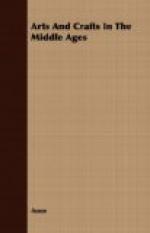The great silver altar in the Baptistery in Florence occupied nearly all the goldsmiths in that city. In 1330 the father of the Orcagnas, Cione, died; he had worked for some years before that on the altar. In 1366 the altar was destroyed, but the parts in bas-relief by Cione were retained and incorporated into the new work, which was finished in 1478. Ghiberti, Orcagna, Verocchio, and Pollajuolo, all executed various details of this magnificent monument.
Goldsmiths did not quite change their standing and characteristics until late in the sixteenth century. About that time it may be said that the last goldsmith of the old school was Claude Ballin, while the first jeweller, in the modern acceptation of the word, was Pierre de Montarsy.
Silver has always been selected for the better household utensils, not only on account of its beauty, but also because of its ductility, which is desirable in making larger vessels; its value, too, is less than that of gold, so that articles which would be quite out of the reach of most householders, if made in gold, become very available in silver. Silver is particularly adapted to daily use, for the necessary washing and polishing which it receives keeps it in good condition, and there is no danger from poison through corrosion, as with copper and brass.
In the middle ages the customary pieces of plate in English homes were basins, bottles, bowls, candlesticks, saucepans, jugs, dishes, ewers and flagons, and chafing-dishes for warming the hands, which were undoubtedly needed, when we remember how intense the cold must have been in those high, bare, ill-ventilated halls! There were also large cups called hanaps, smaller cups, plates, and porringers, salt-cellars, spoons, and salvers. Forks were of much later date.
There are records of several silver basins in the Register of John of Gaunt, and also in the Inventory of Lord Lisle: one being “a basin and ewer with arms” and another, “a shaving basin.” John of Gaunt also owned “a silver bowl for the kitchen.” If the mediaeval household lacked comforts, it could teach us lessons in luxury in some other departments! He also had a “pair of silver bottles, partly gilt, and enamelled, garnished with tissues of silk, white and blue,” and a “casting bottle” for distributing perfume: Silver candelabra were recorded; these, of course, must have been in constant service, as the facilities for lighting were largely dependent upon them. When the Crown was once obliged to ask a loan from the Earl of Salisbury, in 1432, the Earl received, as earnest of payment, “two golden candelabra, garnished with pearls and precious stones.”




